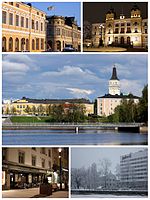
Photo from wikipedia
Abstract In cold climate regions, ice roads are engineered as temporary winter transportation routes on frozen lakes, rivers and seas. The ice road season start, end and duration principally depend… Click to show full abstract
Abstract In cold climate regions, ice roads are engineered as temporary winter transportation routes on frozen lakes, rivers and seas. The ice road season start, end and duration principally depend upon ice thickness, which is controlled by surface air temperature (SAT) in terms of freezing and thawing degree-days (FDD and TDD, respectively). Both FDD and TDD are indicators of climate variability and change, and are naturally influenced by large-scale atmospheric circulation patterns (ACPs). This study examined the role of ACPs in interannual variations in the operating season of the Oulu-Hailuoto ice road in the Bay of Bothnia, northern Baltic Sea, during 1974–2009. Significant (p
Journal Title: Cold Regions Science and Technology
Year Published: 2018
Link to full text (if available)
Share on Social Media: Sign Up to like & get
recommendations!